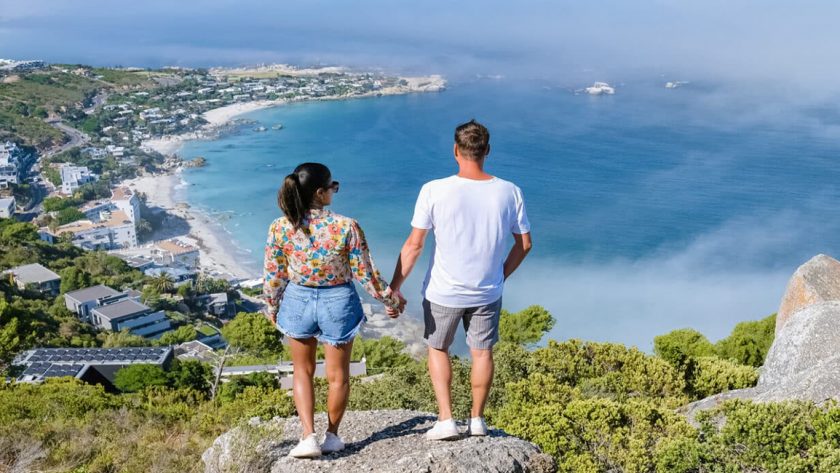Far away from Johannesburg, resting at the foot of the majestic Table Mountain, lies Capetown. A mixture of old and new, poor and rich, Capetown is a beautiful city offering a paradox of cultures. Blessed by the seafront and clean beaches, and backed by a ridge of mountains, Capetown has rightly enjoyed its status as one of the world’s most attractive cities.
I think the local wine, not to mention the beaches and scenery, has a lot to do with Capetonians being much more laid back than their counterparts in Johannesburg. There are easily 20 good wineries within a 50-mile radius from Capetown, all of which welcome visitors with open arms. The Stellenbosch and Franschhoek regions are wonderful, beautiful areas to savor a vintage bottle of South Africa’s finest. Easily accessible and reasonably affordable, wine tasting is an excellent day trip out of Capetown.
Hiking up Table Mountain makes for another wonderful trip. It’s an all-day affair but one well worth the exertion. The majestic views, at every step and especially as you reach the summit, are awe-inspiring and stunning. once atop the “table,” you can choose from any number of 10- to 45-minute walks on well-marked trails. The view south reveals the rock cliffs of the 12 Apostles. Looking down and to the northwest you will see the city of Capetown, cradled in Table Bay. And to the southwest lies beautiful Camps Bay, where the mountain meets the sea amid crashing waves and white sand. Take the tram up (and down) if you think the hike would be too much, but be sure to ask when the last tram leaves in the evening, or it could be a cold night.
Whale watching, while not on the top of some lists when visiting South Africa, proved to be a wonderful excursion. Hermanus, a small village on the south coast boasts the world’s best land-based whale watching. At the water’s edge, cliffs plummet straight down into the water, allowing the migrating whales to feed close to shore. Watching enormous southern right whales, with their callosities (large patches of rough skin often mistaken for barnacles) feed off shore just meters away provided yet another magnificent animal encounter in South Africa. The natural beauty of the Western Cape never failed to impress me.
Her history proves not so attractive, though, as one looks north from shore to Africa’s most infamous island. Off the coast of South Africa’s Capetown sits Robben Island, a prison much like San Francisco’s Alcatraz.
The imposing prison was the primary holding facility of Nelson Mandela, keeping the former President behind bars for 18 of his 27 years. Our guide had spent much of his time behind bars with Mandella and shared some inspiring stories with us. Mandela, while imprisoned at Robben Island, vowed to turn the prison into a university. This remarkable man turned the worst and most helpless situation into a positive experience. Our guide recounted to us how Mandela petitioned for years to get books and when he finally did receive them, how groups of student-inmates would study into the night. When the guards would turn off the main lights Mandela would instruct his students to go into the bathrooms and study using the single light bulb as their only source of illumination. He kept a positive frame of mind at all times and was a source of inspiration for the inmates. Seeing his cell shocked me. The staff now running the island kept the cell as it did when he occupied by the South African leader. It was tiny, with all-gray walls, ceiling, floor and bars. The only break for the eye was a light brown mat on the floor and a few books. It made me angry and I was suddenly overcome and surprised by this emotion. It was an odd, uncomfortable feeling. I simply cannot imagine what these men, prisoners of conscience, experienced on a daily basis.
“They beat us,” he said. “They would round us up at any hour of the day or night, bring us into the yard and beat and whip us. There was never any reason given for these beatings.”
I watched him as he lectured our group, his face black as night, his eyes inset deep in his skull. Our guide told us some startling statistics: they were not allowed beds until 1978. The black prisoners had to sleep on half-inch thick mats on the cold cement floor. He remembered not being served bread for 12 years. The only thing they were given to eat was a corn paste and only water to drink.
The letters they wrote to loved ones were censored. Sometimes the guards would receive a letter addressed to one of the inmates and cut out its entire text, leaving only a salutation and the person’s signed name. The white guards, we were told, constantly did these sorts of things in an effort to quash the spirit of the inmates. At times the guards would have a woman write to an inmate, mimicking that inmates wife’s handwriting and state that the wife was leaving him. He told us that this, at times, broke their spirit.



